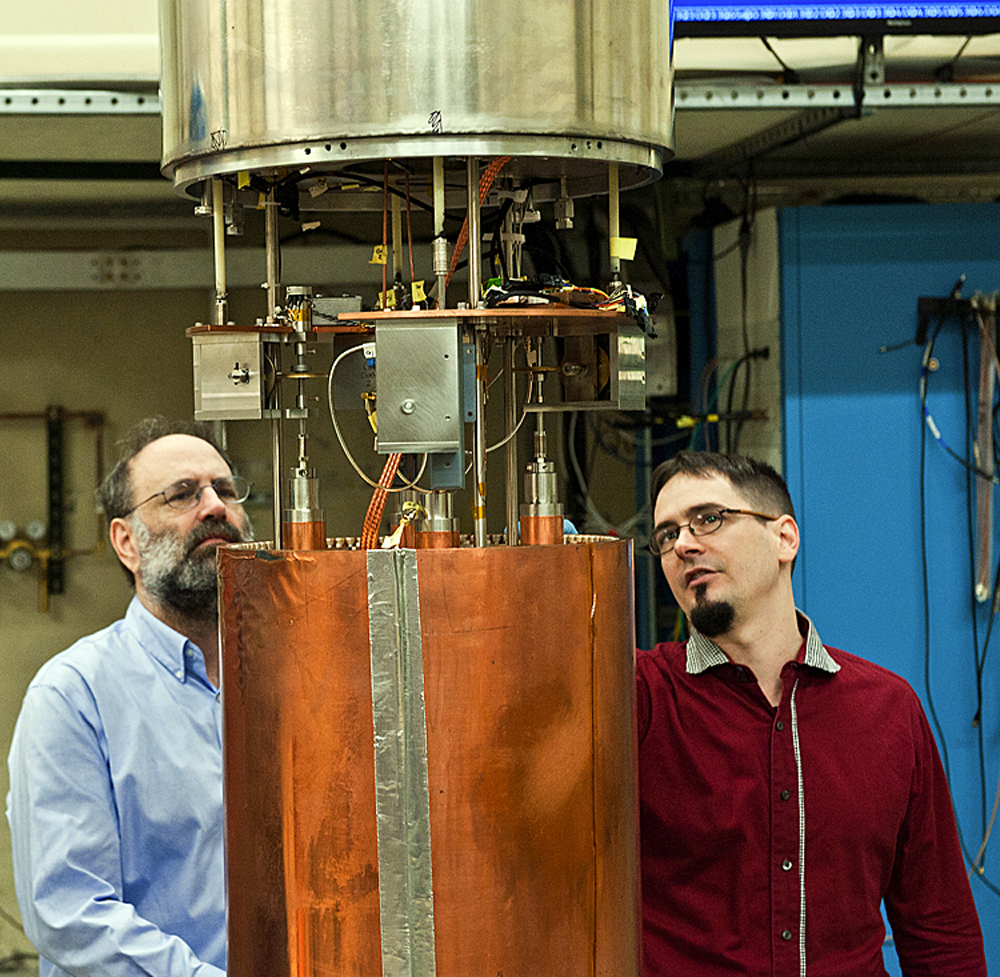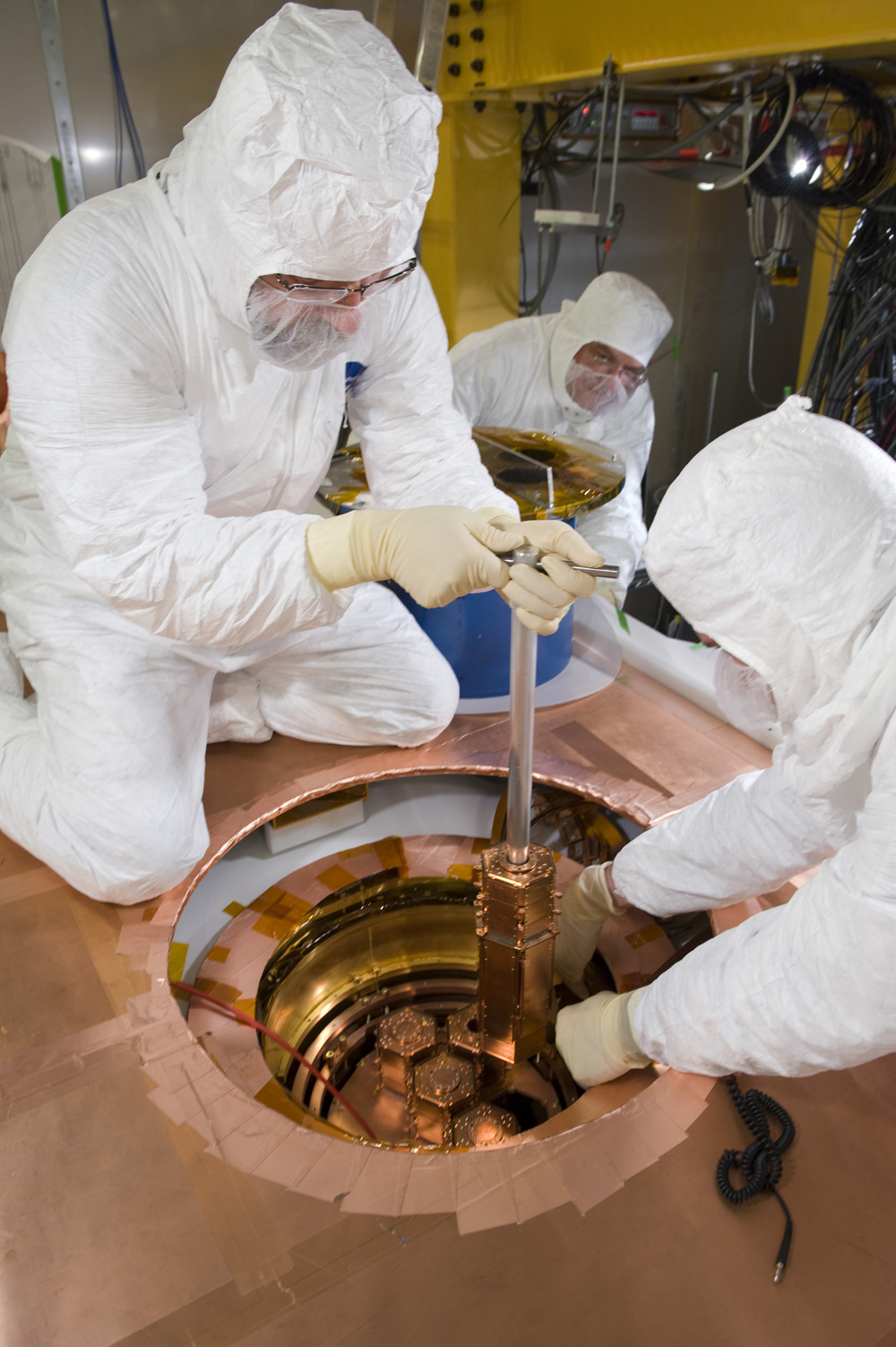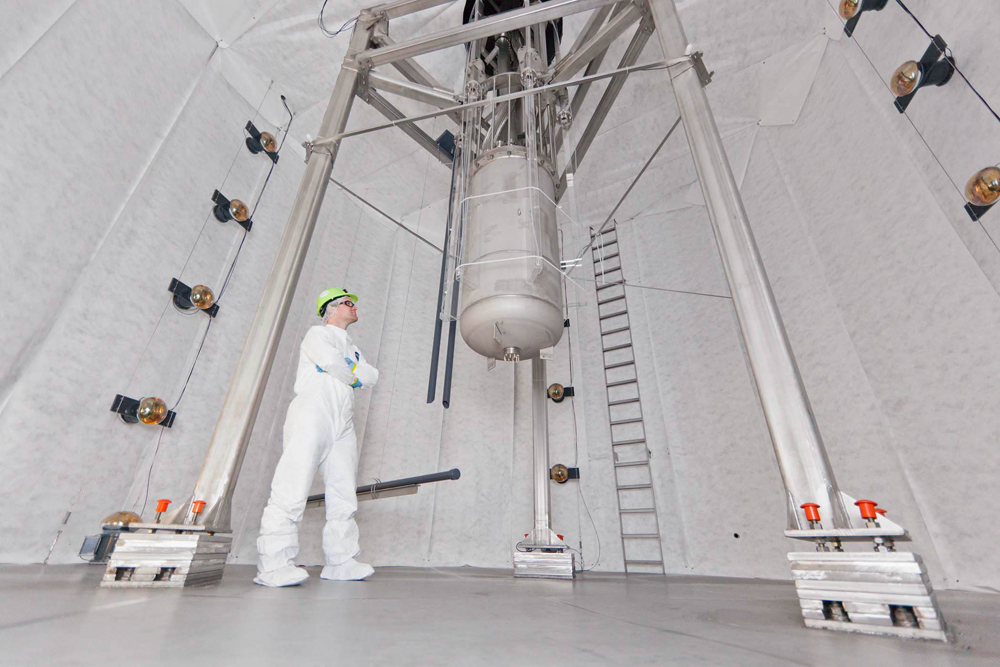Lighting the Way: A Conversation with 3 Dark Matter Explorers (Q+A)


Kelen Tuttle, writer and editor for the Kavli Foundation, contributed this article to Space.com's Expert Voices: Op-Ed & Insights.
This month, three new experiments take significant steps in the hunt for dark matter, the elusive substance that appears to make up more than a quarter of the universe, but interacts very rarely with the matter that makes up our world. The experiments — the Axion Dark Matter eXperiment Gen 2, LUX-ZEPLIN (LZ) and the Super Cryogenic Dark Matter Search at SNOLAB — learned in July that each would receive much needed funding from the U.S. Department of Energy and the U.S. National Science Foundation. Each of these "second-generation" experiments will be at least 10 times more sensitive than today's dark matter detectors, increasing the likelihood that they will see the small, rare interactions between dark matter and the regular matter we all interact with every day.
As the experimental plans start to coalesce and detector equipment starts to arrive for ADMX Gen2, LZ and SuperCDMS SNOLAB, The Kavli Foundation brought together three scientists to discuss the likelihood that these projects will, at long last, discover dark matter.
In the Q+A below, the three researchers share their perspectives on the dark matter hunt.
And on Nov. 20, from 3:00 p.m. to 3:30 p.m. EST, Enectali Figueroa-Feliciano, Harry Nelson and Gray Rybka will answer your questions about the next generation of dark matter experiments in a live webcast. (Submit your questions ahead of, and during, the webcast by emailing info@kavlifoundation.org or by using the hashtag #KavliLive on Twitter or Google+.)
Enectali (Tali) Figueroa-Feliciano is a member of the SuperCDMS collaboration and an associate professor of physics at the MIT Kavli Institute for Astrophysics and Space Research.
Harry Nelson is science lead for the LUX-ZEPLIN experiment and professor of physics at the University of California, Santa Barbara.
Breaking space news, the latest updates on rocket launches, skywatching events and more!
Gray Rybka is co-lead and co-spokesman for the ADMX Gen 2 experiment, and a research assistant professor of physics at the University of Washington.
Q+A:
The Kavli Foundation: We know that dark matter is five times more prevalent than ordinary matter, and we're able to infer that clumps of dark matter help hold together clusters of galaxies. So this substance is a huge part of what makes up our universe and an important part of why our universe looks the way it does. Why, then, haven't we been able to observe it directly? What's holding us back?
Harry Nelson: A big part of the challenge is that dark matter doesn't interact with us very much. We know that dark matter is passing through our galaxy all the time, but it doesn't disrupt the type of matter we're made of.
But more than that, dark matter doesn't interact with itself very much either. The matter that we see around us every day interacts with itself: Atoms form molecules, the molecules form dirt, and the dirt forms planets. But that's not the case with dark matter . Dark matter is widely dispersed, and doesn't form dense objects like we're used to. That, combined with the fact that it doesn't interact with our type of matter very often, makes it hard to detect.
Tali Figueroa-Feliciano: What Harry says is exactly right. In my mind, nature is being coy. There's something we just don't understand about the internal structure of how the universe works. When theorists write down all the ways dark matter might interact with our particles, they find, for the simplest models, that we should have seen it already. So even though we haven't found it yet, there's a message there, one that we're trying to decode now.
TKF: In fact, nature is being so coy that we don't yet even know what dark matter particles look like. Gray, your experiment —— ADMX —— looks for a different particle altogether than the one that Tali and Harry look for. Why is that?
Rybka: As you say, my project — the Axion Dark Matter eXperiment, or ADMX —searches for a theoretical type of dark matter particle called the axion, which is extremely lightweight with neither electric charge nor spin. Harry and Tali look for a different type of dark matter called the WIMP, for Weakly Interacting Massive Particle, which describes a number of theorized particles that interact with our world very weakly and very rarely.
Both the WIMP and the axion are really good dark matter candidates. They're especially great because they would explain both dark matter and other mysteries of physics at the same time. I suppose I like the axion because there aren't a lot of experiments looking for it. If I'm going to gamble and spend a lot of time making an experiment to look for something, I don't want to look for something that everyone else is looking for.
We've been updating the ADMX experiment since 2010 and have demonstrated that we have the tools necessary to see axions if they are out there. ADMX is a scanning experiment, where we scan the various masses this axion could have, one at a time. How fast we scan depends on how cold we can make the experiment. With Gen2, we're buying a very, very powerful refrigerator that will arrive next month. Once it arrives, we'll be able to scan very, very quickly and we feel we'll have a much better chance of finding axions — if they're out there.
TKF: And, Harry, why do you bet on the WIMP?
Nelson: Even though I'm betting on WIMPs, I like axions too. I even wrote some papers on axions way back when. But these days, as Gray said, I look for WIMPs. My collaboration is currently operating the Large Underground Xenon, or LUX, experiment in the famous Black Hills of South Dakota, inside a mine that was the outgrowth of the 1876 gold rush that formed the city Deadwood. This month, we start our 12-month run with LUX. We're also now carefully developing our plans to upgrade our detector to make it more than 100 times more sensitive for the new LUX-ZEPLIN project.
But to tell you the truth, I actually have a little bit of the attitude that all of these possibilities are unlikely. I'm not saying that hunting for them is worthless; that's not it at all. It's just that nature doesn't have to respect what physicists want. We desire to better understand our own strong interaction, the mechanism responsible for the strong nuclear force which holds the atomic nucleus together. The axion would help do that.
The WIMP is great because it's consistent with the physics of the Big Bang in a straightforward way. A lot of science is based on what's called Occam's razor: We make the simplest possible assumptions and then test them very well, and only give up simplicity if we absolutely need to. I've always felt that the WIMP is a tiny bit simpler than the axion. Both are unlikely, but are still the best candidates we can think of. It's probably more likely that dark matter is somewhat different than either the WIMP or the axion, but we must start somewhere and the WIMP and axion are the best starting points we can imagine.
TKF: If you think it's unlikely that the WIMP is out there, why do you look for it?
Nelson: The WIMP and axion have the absolute best theoretical motivations. And so it's great that both WIMPs and axions have really strong experiments going after them.
Figueroa-Feliciano: As an experimentalist, I come at this from the point of view that theorists are very clever, and have come up with an incredible array of possible scenarios for what dark matter could be. And, as Harry said, we attempt to use Occam's razor to try to weed out which of these things are more probable than the others. But that's not an infallible way to go about it. Dark matter might not follow the simplest explanation possible. So we have to be a little agnostic about it.
In a way it's like looking for gold. Harry has his pan and he's looking for gold in a deep pond, and we're looking in a slightly shallower pond, and Gray's a little upstream, looking in his own spot. We don't know who's going to find gold because we don't know where it is.
That said, I think it's really important to stress how complementary these three searches are. Together, we look in a lot of the places where dark matter could be. But we certainly don't cover all of the options. As Harry says, it could be that dark matter is there, but our three experiments will never see anything because we're looking in the wrong place — it could be in another fork of the river, where we haven't even started looking yet.
Rybka: I look at it a bit more optimistically. Although as Tali said all the experiments could be looking in entirely the wrong place, it's also possible that they'll all find dark matter. There's nothing that would require dark matter to be made of just one type of particle except us hoping that it's that simple. Dark matter could be one-third axions, one-third heavy WIMPs and one-third light WIMPs. That would be perfectly allowable from everything we've seen.
Figueroa-Feliciano: I agree. I should have said that the gold nugget we're looking for is a very valuable one. So even though the search is hard, it's worthwhile because we're looking for a very valuable thing: to understand what dark matter is made of and to discover a new part of our universe. There's a very beautiful prize at the end of this search, so it's absolutely worthwhile.
TKF: Tali, tell us a little about the pond where you're panning for that very valuable nugget of dark matter.
My experiment is currently running in Soudan, Minnesota, inside a mine that's about a half a kilometer (about 1,640 feet) underground. This experiment, called SuperCDMS Soudan, was designed to demonstrate a new technology we've been developing that allows us to search for WIMPs that are on the lighter-mass side. It turns out that certain classes of WIMPs, ones that are lighter than Harry searches for, deposit very little energy into detectors. Our detectors are able to distinguish very small amounts of energy deposited in the detector from all the many different signals that we get from radioactive materials, cosmic rays, and all sorts of other things that stream though our detectors. Being able to make that separation is very important, both for SuperCDMS and for LZ.
The next step for our experiment is called SuperCDMS SNOLAB. SNOLAB is a nickel mine in Canada that's 2 kilometers (6,531 feet) deep. We've been approved to build a brand new experiment down there to search for these low-mass WIMPs. Also, if LUX or LZ sees a higher mass WIMP, we'll be able to check that measurement. Right now, we're in the process of finalizing the design and taking the first steps of putting this brand-new SNOLAB experiment together. We expect to have a first phase of detectors in the next couple of years.
TKF: If one of your experiments finds evidence of dark matter, after the celebratory champagne, what would be the next steps?
Rybka: Bottle it and sell it, I guess! But really, I'd say that all of the experiments would need to keep going even after such a discovery, until someone could conclusively prove that the discovered dark matter makes up 100 percent of all the dark matter in the universe.
Nelson: I would agree with that. We would also need to dig in and really try to understand what we discovered. There's an old saying in particle physics that you haven't discovered a particle until you know its mass, spin and parity, a property that's important in the quantum-mechanical description of a physical system. To really discover dark matter, we'll need to prove that it's what we think it is, and we'll need to learn its characteristics. After you discover a particle, everyone gets a lot smarter at what to do with it. This has been going on with the Higgs boson lately. Folks at the Large Hadron Collider are getting cleverer because now that they've seen the particle, they can focus on interrogating it.
When we start to do that with dark matter, we're going to see something new. That's just how scientific progress works. Right now, we can't see through the wall because we haven't figured out what the wall is made of. But once we understand what's in the wall — my analogy for dark matter — we'll see through it and see to the next thing.
Figueroa-Feliciano: Let me add my two cents to that. There are three different things that I think would happen if one of our experiments saw convincing evidence for dark matter. First, we would want to confirm the discovery using a different technique. In other words, we will want as much confirmation as we can before we declare victory.
Then, people will come up with 100 different ways to test the particle's properties, as Harry described. After that, a phase of "dark matter astronomy" will help us learn the particle's role in the universe. We'll want to measure how fast it's going, how much of it there is, how it behaves in a galaxy.
TKF: There's clearly a lot to be done once we find even just one type of dark matter particle. But it sounds like there could be a whole new zoo of dark particles. Do you think we're going to need a "Dark Standard Model?"
Nelson: I've often had the following thought: Here we are, in our measly 15 percent of the matter in the universe, wondering what dark matter is. If dark matter is as complex as we are, it might not even know that we exist. We're just this minority 15 percent, but somehow we think we're so important. But experiments undertaken by dark matter might not even know that we exist because we're a much smaller perturbation on dark matter's world than dark matter is on us.
The dark matter sector may be as complex — or perhaps even five times as complex — as ours. Just as we're made mostly of atoms made up of electrons and nuclei, maybe dark matter is too. In some of the searches for WIMPs, you have to be careful about that. It may be that the way these things interact with our matter is rather different than the simplest possible case that we're looking for.
Figueroa-Feliciano: Harry, if you were to apply Occam's razor to our universe, how does it fare with the Standard Model?
Nelson: Well, it doesn't do very well. The Standard Model is a lot more complex than it needs to be. So maybe the same is true for dark matter. Maybe there are even dark photons out there. The idea is interesting. With ADMX, Gray is looking for a particle that has to do with the strong interaction. Tali and I are looking for a particle that has to do with the weak interaction. And searches for the dark photon look for a relationship between the electromagnetic interaction and the dark matter sector. [Quantum Dropleton: Weird New Particle Acts Like Liquid ]
The community really wants to figure out dark matter. There's a feeling of urgency about it, and we'll look for it in all the ways that we can.
Rybka: It's true. With ADMX, we're mostly focused on the axion, but we also look for dark photons at the lower masses. There are the dark matter candidates that people are really, really excited about, like axions and WIMPs. Those get experiments built that are dedicated to them. And then there are the ideas that might be good but don't have quite as much motivation, like dark photons. People still look for ways to test those ideas, often with existing experiments.
TKF: It's clear there are a wide variety of places where we could find dark matter. We're panning for this gold wherever we can, but we're not entirely sure that it exists anywhere we're looking. What's it like searching for something that you might never find?
Figueroa-Feliciano: I think that the people who work on dark matter have a certain personality, a bit of a gambler's streak. We go for the high stakes, putting all the chips in. There are other areas of physics where we would be sure to see something. Instead, we choose to look for something that we might not actually see. If we do see it, though, it's a huge deal.
We're extremely lucky that we actually get paid to try to figure out what the universe is made of. That's an incredibly wonderful thing.
Nelson: Sometimes I think of what it must have been like to be Columbus and his crew, or the explorers who first went to the Earth's poles. They were way out in the middle of the ocean, or in the ice, not quite sure what would come next. But they had set goals: India and China for Columbus, the poles for those explorers. We're explorers too, we set goals for ourselves too, to seek certain pre-defined sensitivities to dark matter. We're innovating with modern technology to reach our specific goals. And we may make it the New World or the North Pole, and that's wonderfully exciting.
Follow all of the Expert Voices issues and debates — and become part of the discussion — on Facebook, Twitter and Google+. The views expressed are those of the author and do not necessarily reflect the views of the publisher. This version of the article was originally published on Space.com.
A former contributor to Space.com, Kelen is currently the Senior Director of Creative Services for GeneDx where she acts as an in-house agency dedicated to bringing the GeneDx brand to life consistently and effectively. Prior to this position she was a freelance science writer and editor after stints as the EIC of Symmetry Magazine and six years at the SLAC National Accelerator Laboratory, She obtained her MS in Science Journalism from Boston University after her undergraduate work in Physics and Astrophysics from Carleton College.



